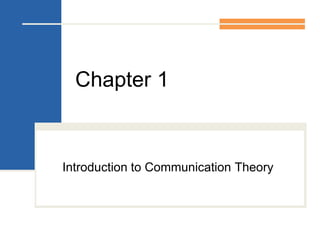
5.7 chapter 1
- 1. Chapter 1 Introduction to Communication Theory
- 2. Definitions of Communication Everyday view of communication is the flow of information from one person to another. Communication: the process by which people interactively create, sustain, and manage meaning.
- 3. As a group, set course Ground Rules
- 4. Communication Competence Communication competence: balancing effectiveness and appropriateness. Effectiveness: extent to which you achieve your goals in interaction. Appropriateness: fulfilling social expectations for a particular situation. Understanding theory will allow for a proper balance of effectiveness and appropriateness
- 5. What is Theory? Abstract understanding of communication process. Move beyond describing a single event by providing a means by which all like events can be described. Defined: systematic summary about the nature of the communication process. Functions include: Focusing attention on particular concepts Clarifying our observations Predicting communication behavior Generating personal and social change
- 6. Types of Theory Commonsense theory Theories-in-use Created through personal experiences Are often the basis for our decisions on how to communicate E.g.: Never date a colleague; it always ends up badly
- 7. Types of Theory Working theory Generalizations made in particular professions about the best technique for doing something More systematic than commonsense theory represent agreed-on ways of doing things in professions. E.g.: Audience analysis should be done prior to presenting a speech.
- 8. Types of Theory Scholarly theory Has undergone systematic research Provide more thorough, accurate, and abstract explanations for communication Typically more complex and difficult to understand E.g.: The media do not tell us what to think, but what to think about (agenda-setting theory)
- 9. Criteria for Evaluating Theory Accuracy Correctly summarizes the way communication actually works Look at research studies that use the theory and see whether the research supports the theory or fails to support it.
- 10. Criteria for Evaluating Theory Practicality How well the theory can be used to address real-world communication problems A theory with more applications is better than a theory without practical uses Look for how the theory has been used in the research literature as well as a theory’s professional application
- 11. Criteria for Evaluating Theory Succinctness Is the theory formulated as simply as possible? Compare how much of communication is explained by the theory versus how many concepts are being used to explain it
- 12. Criteria for Evaluating Theory Consistency The most useful theories have internal and external consistency Internal consistency means that the ideas of the theory are logically built on one another External consistency refers to the theory’s consistency with other widely accepted behaviors
- 13. Criteria for Evaluating Theory Acuity The ability of a theory to provide insight into an otherwise intricate issue You need to think, “Wow, I never realized that!”
- 14. Application: Case Study Case Study 1: Evaluating Groupthink How accurate is groupthink? How practical is groupthink? Is the theory appropriately succinct? Or is it overly simple or overly complex? Is groupthink consistent with other theories about group communication? Does it demonstrate internal consistency? Does groupthink demonstrate acuity?
- 15. Criteria for Evaluating Theory Accuracy AcuityPracticality Succinctness Consistency
